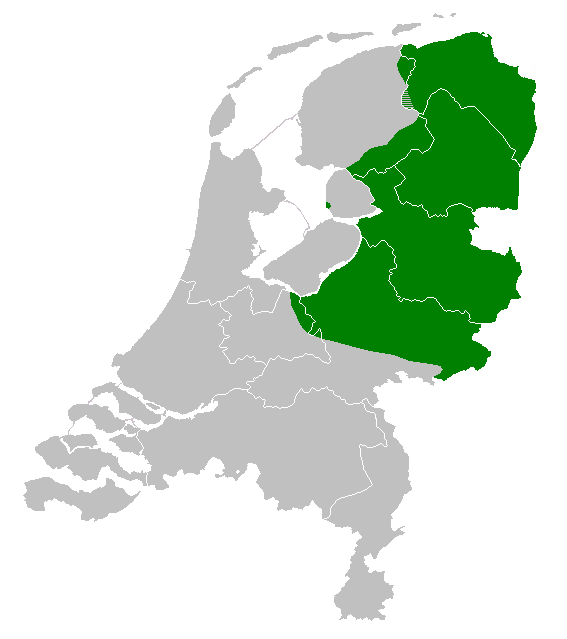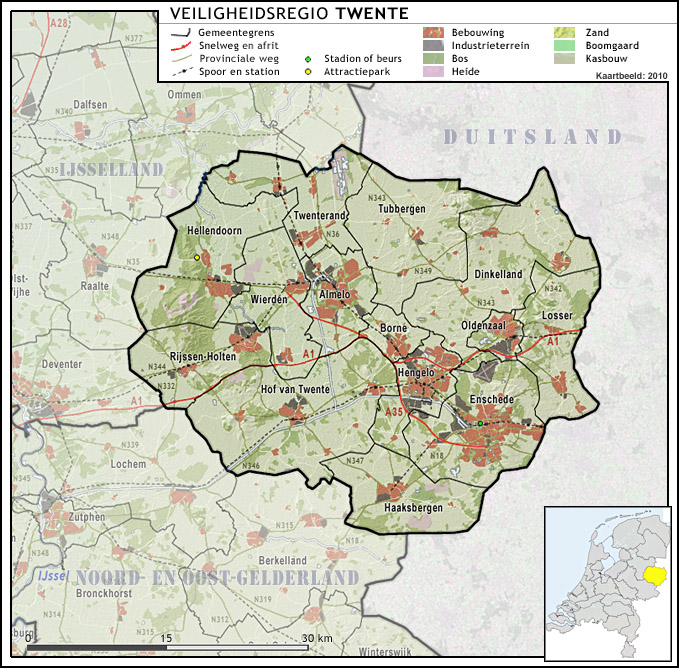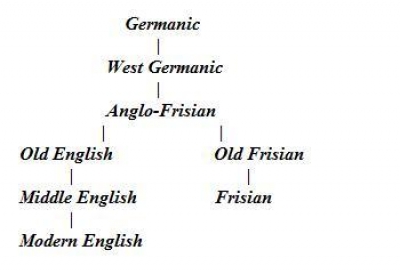|
Tweants
Tweants (Tweants pronunciation: ; nl, Twents ) is a group of non-standardised, closely related Westphalian, Dutch Low Saxon dialects, descending from Old Saxon. It is spoken daily by approximately 62% of the population of Twente, a region in the eastern Dutch province of Overijssel bordering on Germany. Tweants is part of the larger Low Saxon dialect continuum, spreading from the Veluwe region in the middle of the Netherlands to the German-Polish border. As a consequence, it shares many characteristics with surrounding dialects, such as Sallaans and Achterhooks in the Netherlands, and Westmünsterländisch in Germany. All towns and villages in Twente have their own local, but mutually intelligible variety. Due to this fragmentation and lack of a standard variety, many speakers of Tweants call it by the locality their variety is from (e.g. a person from Almelo would say they speak "Almeloos" rather than "Tweants"). Alternatively, speakers combine the names: a speaker from Rij ... [...More Info...] [...Related Items...] OR: [Wikipedia] [Google] [Baidu] |
Dutch Low Saxon
Dutch Low Saxon ( or ''Nederlaands Nedersaksies''; nl, Nederlands Nedersaksisch) are the Low Saxon dialects of the Low German language that are spoken in the northeastern Netherlands and are written there with local, unstandardised orthographies based on Standard Dutch orthography. The UNESCO Atlas of endangered languages lists the language as vulnerable. The percentage of speakers among parents dropped from 34% in 1995 to 15% in 2011. The percentage of speakers among their children dropped from 8% to 2% in the same period. According to a 2005 study 53% speaks Low Saxon or Low Saxon and Dutch at home and 71% could speak it in the researched area. The Netherlands recognizes Dutch Low Saxon as an official regional language under the European Charter for Regional or Minority Languages. Classification The classification of Dutch Low Saxon is not unanimous. From a diachronic point of view, the Dutch Low Saxon dialects are merely the West Low German (Northern Low Saxon and Friso-S ... [...More Info...] [...Related Items...] OR: [Wikipedia] [Google] [Baidu] |
Rijssen
Rijssen (; nds-nl, Riesn, ) is a city in the Dutch province of Overijssel. It is part of Rijssen-Holten, one of thirteen municipalities in Twente. It has almost 28,000 inhabitants. The economy of Rijssen relies mostly on commerce and construction and transport companies. History Archeological evidence shows that the monk Lebuinus founded a church in Rijssen, as early as the seventh century, as part of a coordinated attempt to convert the local pagan Saxons to Christianity, though other archaeological finds, such as urns and grave mounds suggest habitation dating back as far as 5,000 years. Rijssen was first mentioned as ''Parrochia Risnen'' on a freight letter dating from 1188 by the Count of Dalen. After having a disagreement with the Viscount of Goor, Bishop Otto III van Holland granted city rights to Rijssen on 5 May 1243. The original city rights bill was lost in a large fire that swept through the town, reducing the town hall and the keep to rubble. In 2006, however, a c ... [...More Info...] [...Related Items...] OR: [Wikipedia] [Google] [Baidu] |
West Low German
Low Saxon, also known as West Low German ( nds, Nedersassisch, Nedersaksies; nl, Nedersaksisch) are a group of Low German dialects spoken in parts of the Netherlands, northwestern Germany and southern Denmark (in North Schleswig by parts of the German-speaking minority). It is one of two groups of mutually intelligible dialects, the other being East Low German dialects. A 2005 study found that there were approximately 1.8 million "daily speakers" of Low Saxon in the Netherlands. 53% spoke Low Saxon or Low Saxon and Dutch at home and 71% could speak it. loemhoff, H. (2005). Taaltelling Nedersaksisch. Een enquête naar het gebruik en de beheersing van het Nedersaksisch in Nederland. Groningen: Sasland./ref> According to another study the percentage of speakers among parents dropped from 34% in 1995 to 15% in 2011. The percentage of speakers among their children dropped from 8% to 2% in the same period. Extent The language area comprises the North German states of Lower Saxony, N ... [...More Info...] [...Related Items...] OR: [Wikipedia] [Google] [Baidu] |
Standard Dutch
Dutch ( ) is a West Germanic language spoken by about 25 million people as a first language and 5 million as a second language. It is the third most widely spoken Germanic language, after its close relatives German and English. ''Afrikaans'' is a separate but somewhat mutually intelligible daughter languageAfrikaans is a daughter language of Dutch; see , , , , , . Afrikaans was historically called Cape Dutch; see , , , , , . Afrikaans is rooted in 17th-century dialects of Dutch; see , , , . Afrikaans is variously described as a creole, a partially creolised language, or a deviant variety of Dutch; see . spoken, to some degree, by at least 16 million people, mainly in South Africa and Namibia, evolving from the Cape Dutch dialects of Southern Africa. The dialects used in Belgium (including Flemish) and in Suriname, meanwhile, are all guided by the Dutch Language Union. In Europe, most of the population of the Netherlands (where it is the only official language spoken countrywi ... [...More Info...] [...Related Items...] OR: [Wikipedia] [Google] [Baidu] |
Dutch Language
Dutch ( ) is a West Germanic language spoken by about 25 million people as a first language and 5 million as a second language. It is the third most widely spoken Germanic language, after its close relatives German and English. ''Afrikaans'' is a separate but somewhat mutually intelligible daughter languageAfrikaans is a daughter language of Dutch; see , , , , , . Afrikaans was historically called Cape Dutch; see , , , , , . Afrikaans is rooted in 17th-century dialects of Dutch; see , , , . Afrikaans is variously described as a creole, a partially creolised language, or a deviant variety of Dutch; see . spoken, to some degree, by at least 16 million people, mainly in South Africa and Namibia, evolving from the Cape Dutch dialects of Southern Africa. The dialects used in Belgium (including Flemish) and in Suriname, meanwhile, are all guided by the Dutch Language Union. In Europe, most of the population of the Netherlands (where it is the only official language spoken country ... [...More Info...] [...Related Items...] OR: [Wikipedia] [Google] [Baidu] |
Twente
Twente ( nl, Twente , Tweants dialect: ''Tweante'') is a region in the eastern Netherlands. It encompasses the most urbanised and easternmost part of the province of Overijssel. Twente is most likely named after the Tuihanti or Tvihanti, a Germanic tribe that settled in the area and was mentioned by the Roman historian Tacitus. The region's borders are defined by the Overijssel region of Salland in the northwest and west (the river Regge roughly defines the western border), the German County of Bentheim in the northeast and east (the river Dinkel roughly defines the eastern border) and the Gelderland region of the Achterhoek in the south. Twente has approximately 620,000 inhabitants, most of whom live in its three largest cities: Almelo, Hengelo and Enschede, the latter being the main city of the region. It comprises fourteen municipalities: Almelo, Borne, Dinkelland, Enschede, Haaksbergen, Hellendoorn, Hengelo, Hof van Twente, Losser, Oldenzaal, Rijssen-Holten, Tubbergen, Twe ... [...More Info...] [...Related Items...] OR: [Wikipedia] [Google] [Baidu] |
Netherlands
) , anthem = ( en, "William of Nassau") , image_map = , map_caption = , subdivision_type = Sovereign state , subdivision_name = Kingdom of the Netherlands , established_title = Before independence , established_date = Spanish Netherlands , established_title2 = Act of Abjuration , established_date2 = 26 July 1581 , established_title3 = Peace of Münster , established_date3 = 30 January 1648 , established_title4 = Kingdom established , established_date4 = 16 March 1815 , established_title5 = Liberation Day (Netherlands), Liberation Day , established_date5 = 5 May 1945 , established_title6 = Charter for the Kingdom of the Netherlands, Kingdom Charter , established_date6 = 15 December 1954 , established_title7 = Dissolution of the Netherlands Antilles, Caribbean reorganisation , established_date7 = 10 October 2010 , official_languages = Dutch language, Dutch , languages_type = Regional languages , languages_sub = yes , languages = , languages2_type = Reco ... [...More Info...] [...Related Items...] OR: [Wikipedia] [Google] [Baidu] |
Frisian Languages
The Frisian (, ) languages are a closely related group of West Germanic languages, spoken by about 500,000 Frisian people, who live on the southern fringes of the North Sea in the Netherlands and Germany. The Frisian languages are the closest living language group to the Anglic languages; the two groups make up the Anglo-Frisian languages group and together with the Low German dialects these form the North Sea Germanic languages. However, modern English and Frisian are not mutually intelligible, nor are Frisian languages intelligible among themselves, owing to independent linguistic innovations and foreign influences. There are three different Frisian branches, which are usually called the Frisian languages, despite the fact that their so-called dialects are often not mutually intelligible even within these branches. These branches are: West Frisian, which is by far the most spoken of the three and is an official language in the Dutch province of Friesland, where it is spoken ... [...More Info...] [...Related Items...] OR: [Wikipedia] [Google] [Baidu] |
Middle Low Saxon
Middle or The Middle may refer to: * Centre (geometry), the point equally distant from the outer limits. Places * Middle (sheading), a subdivision of the Isle of Man * Middle Bay (other) * Middle Brook (other) * Middle Creek (other) * Middle Island (other) * Middle Lake (other) * Middle Mountain, California * Middle Peninsula, Chesapeake Bay, Virginia * Middle Range, a former name of the Xueshan Range on Taiwan Island * Middle River (other) * Middle Rocks, two rocks at the eastern opening of the Straits of Singapore * Middle Sound, a bay in North Carolina * Middle Township (other) * Middle East Music *Middle (song), "Middle" (song), 2015 *The Middle (Jimmy Eat World song), "The Middle" (Jimmy Eat World song), 2001 *The Middle (Zedd, Maren Morris and Grey song), "The Middle" (Zedd, Maren Morris and Grey song), 2018 *"Middle", a song by Rocket from the Crypt from their 1995 album ''Scream, Dracula, Scream!'' *"The Middle ... [...More Info...] [...Related Items...] OR: [Wikipedia] [Google] [Baidu] |
English Language
English is a West Germanic language of the Indo-European language family, with its earliest forms spoken by the inhabitants of early medieval England. It is named after the Angles, one of the ancient Germanic peoples that migrated to the island of Great Britain. Existing on a dialect continuum with Scots, and then closest related to the Low Saxon and Frisian languages, English is genealogically West Germanic. However, its vocabulary is also distinctively influenced by dialects of France (about 29% of Modern English words) and Latin (also about 29%), plus some grammar and a small amount of core vocabulary influenced by Old Norse (a North Germanic language). Speakers of English are called Anglophones. The earliest forms of English, collectively known as Old English, evolved from a group of West Germanic (Ingvaeonic) dialects brought to Great Britain by Anglo-Saxon settlers in the 5th century and further mutated by Norse-speaking Viking settlers starting in the 8th and 9th ... [...More Info...] [...Related Items...] OR: [Wikipedia] [Google] [Baidu] |
Middle Ages
In the history of Europe, the Middle Ages or medieval period lasted approximately from the late 5th to the late 15th centuries, similar to the post-classical period of global history. It began with the fall of the Western Roman Empire and transitioned into the Renaissance and the Age of Discovery. The Middle Ages is the middle period of the three traditional divisions of Western history: classical antiquity, the medieval period, and the modern period. The medieval period is itself subdivided into the Early, High, and Late Middle Ages. Population decline, counterurbanisation, the collapse of centralized authority, invasions, and mass migrations of tribes, which had begun in late antiquity, continued into the Early Middle Ages. The large-scale movements of the Migration Period, including various Germanic peoples, formed new kingdoms in what remained of the Western Roman Empire. In the 7th century, North Africa and the Middle East—most recently part of the Eastern Ro ... [...More Info...] [...Related Items...] OR: [Wikipedia] [Google] [Baidu] |





